Abstract
1. The discharge behaviour of fourteen single sympathetic vasoconstrictor efferents was studied using a tungsten microelectrode inserted percutaneously into a motor fascicle of the radial or peroneal nerve in eight awake supine subjects. Units were classified as vasoconstrictor because their firing properties correlated appropriately to changes in cardiac interval and arterial pressure. 2. On average, individual vasoconstrictor units discharged in only 21% of heart beats, with an overall mean frequency of 0.47 Hz. Usually only one spike was generated per cardiac cycle. Calculated from cardiac cycles in which a unit fired from two to seven spikes, the mean within-burst firing rate was 18.8 +/- 2.5 Hz (mean +/- S.E.M.); but instantaneous frequencies above 50 Hz were occasionally observed. 3. Measured from a defined R-wave of the ECG, the spike onset latency varied over 358 +/- 33 ms, suggesting considerable variation of synaptic delays in the baroreflex arc. This latency had a relatively uniform temporal relationship with the burst onset or peak latency, compatible with a fixed recruitment order of individual sympathetic neurones. 4. In view of the low average firing rate of individual units we suggest that the variable instantaneous firing rates may optimize the contractile responses of vascular smooth muscle.
Full text
PDF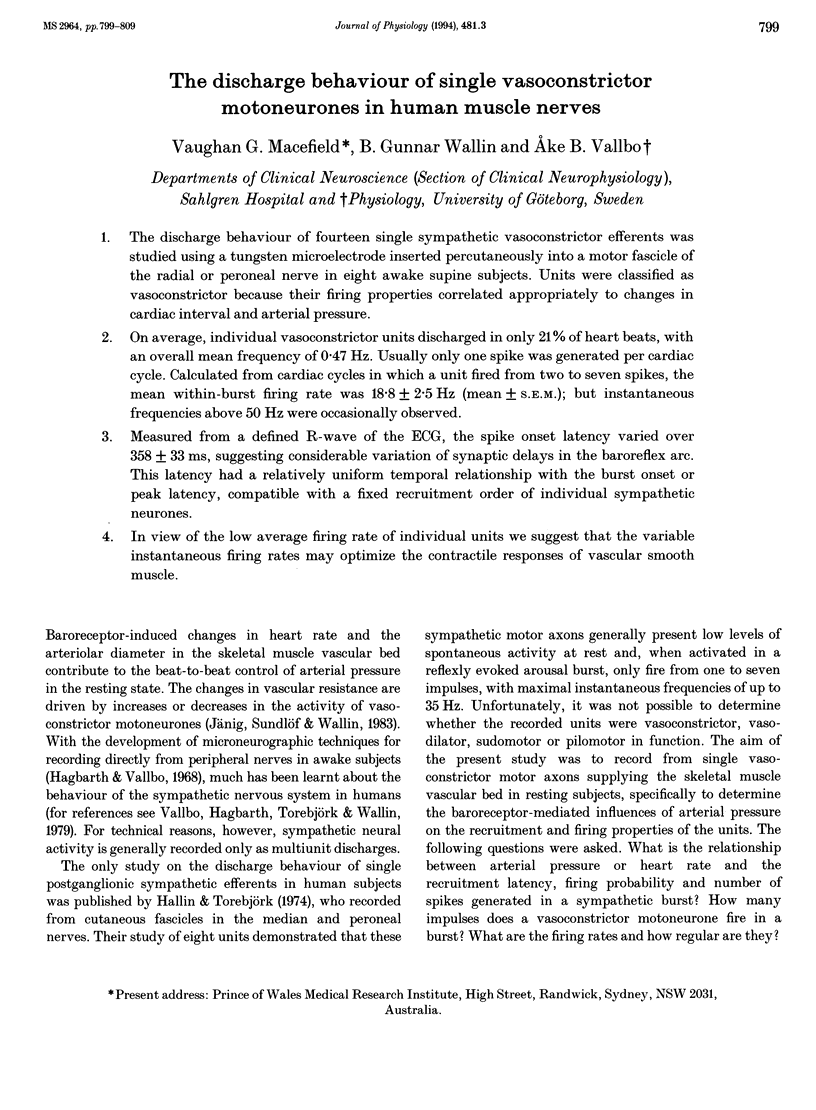
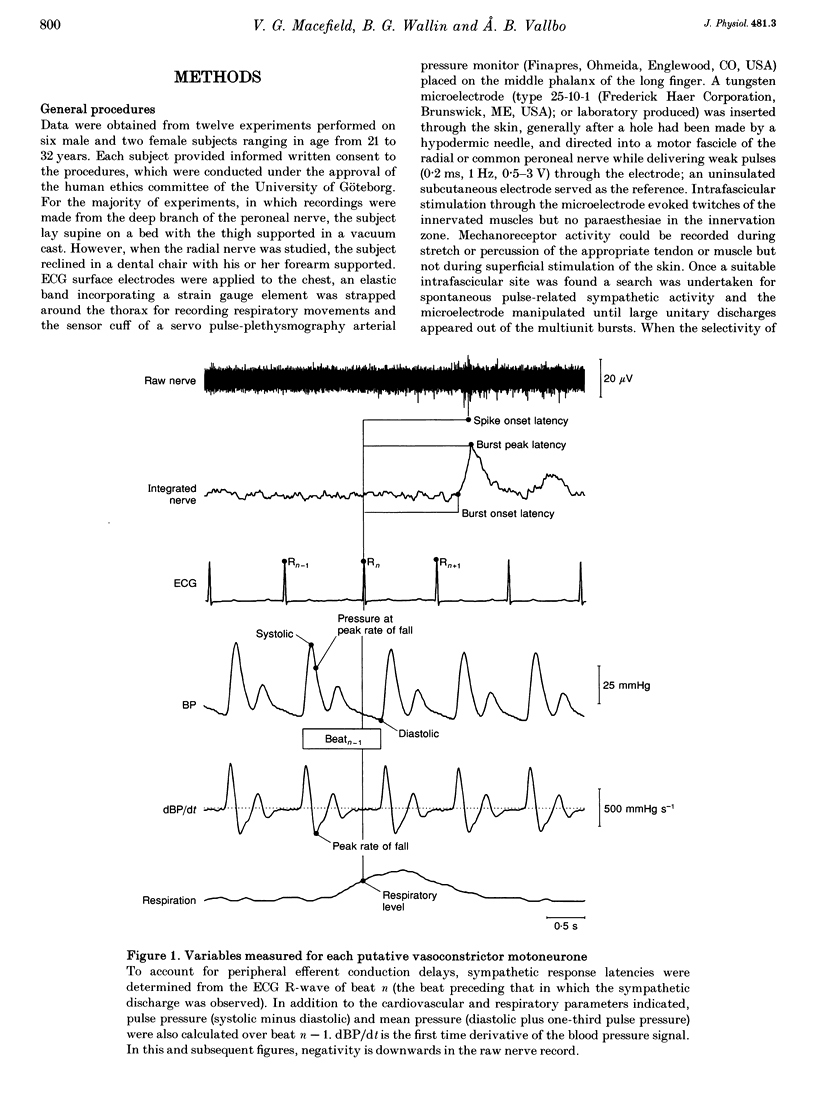
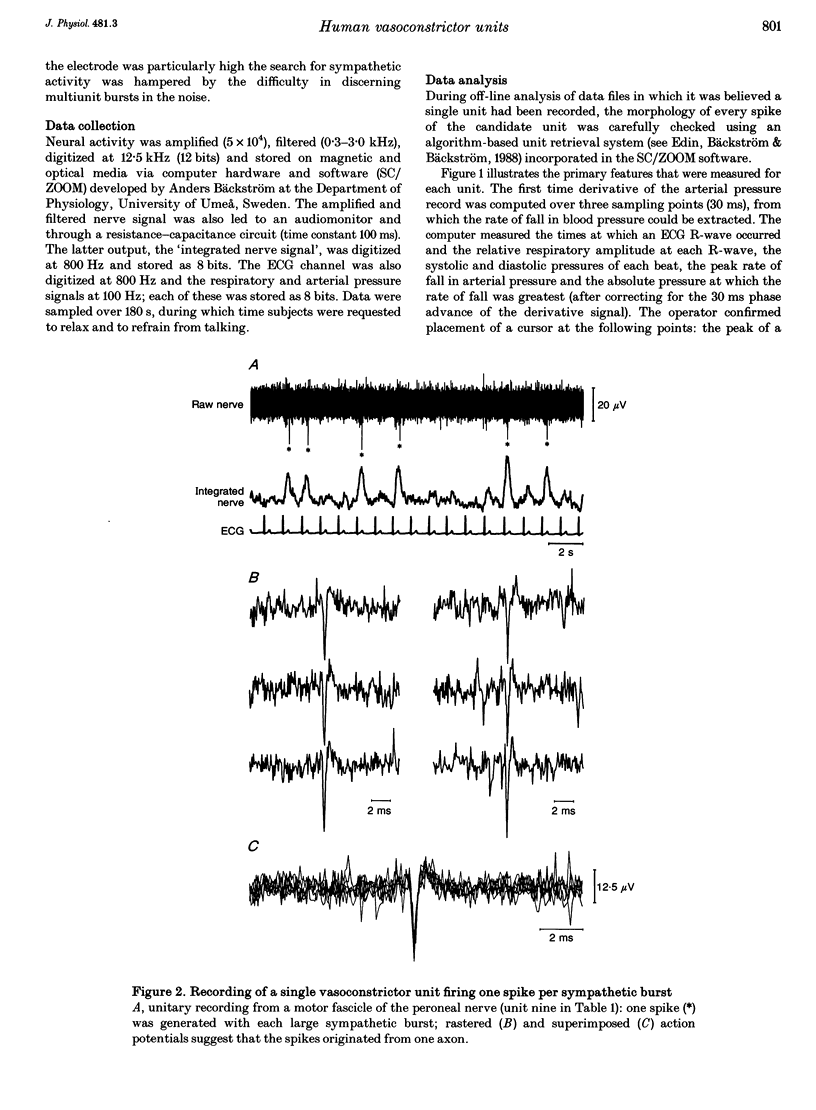
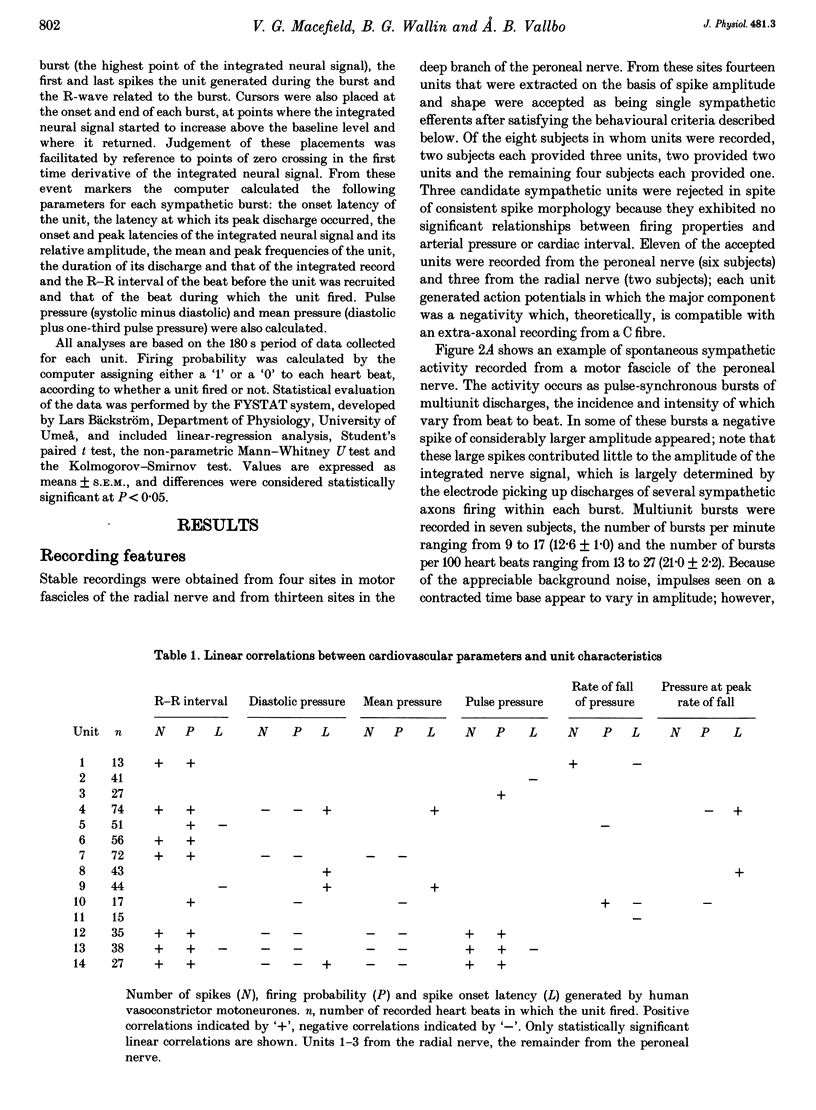
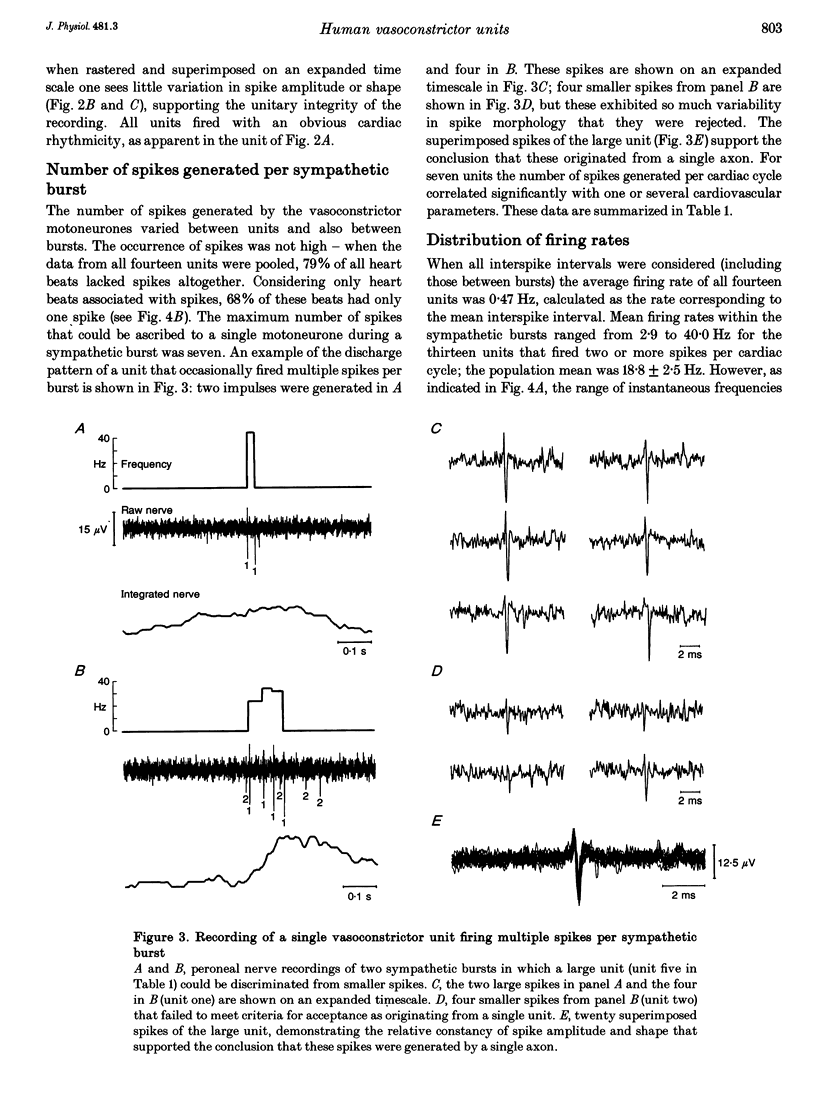
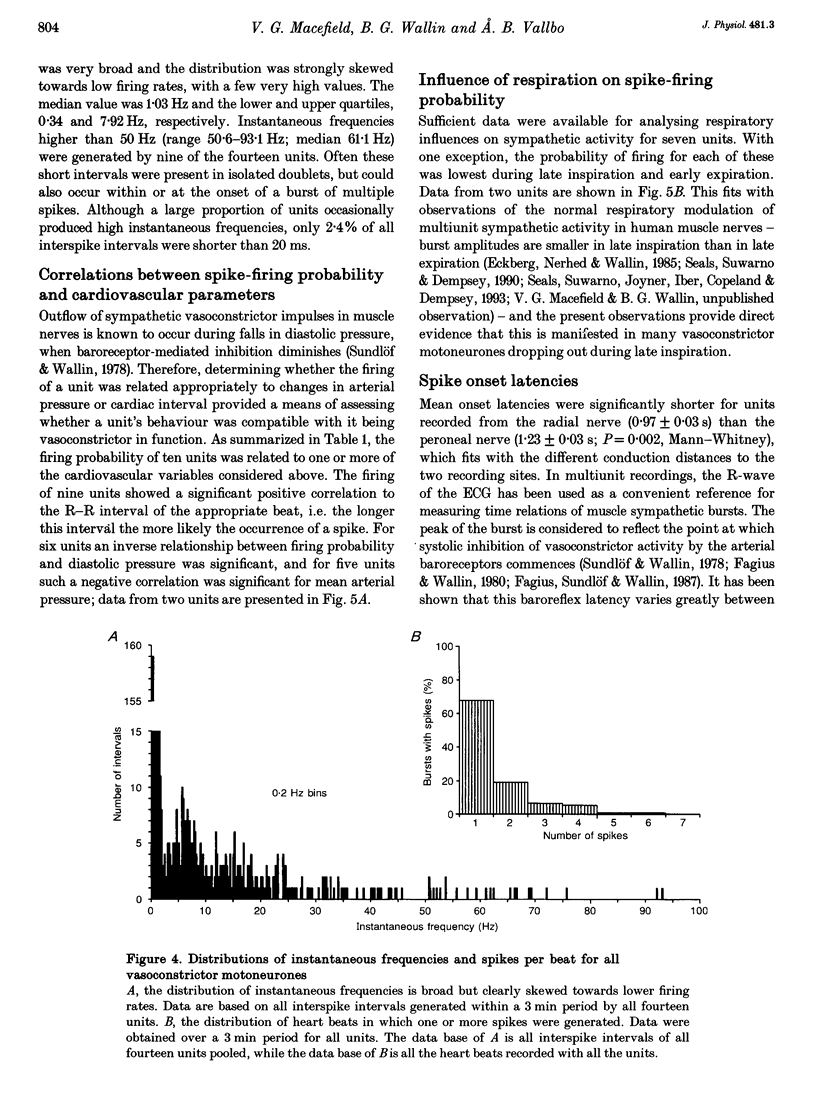
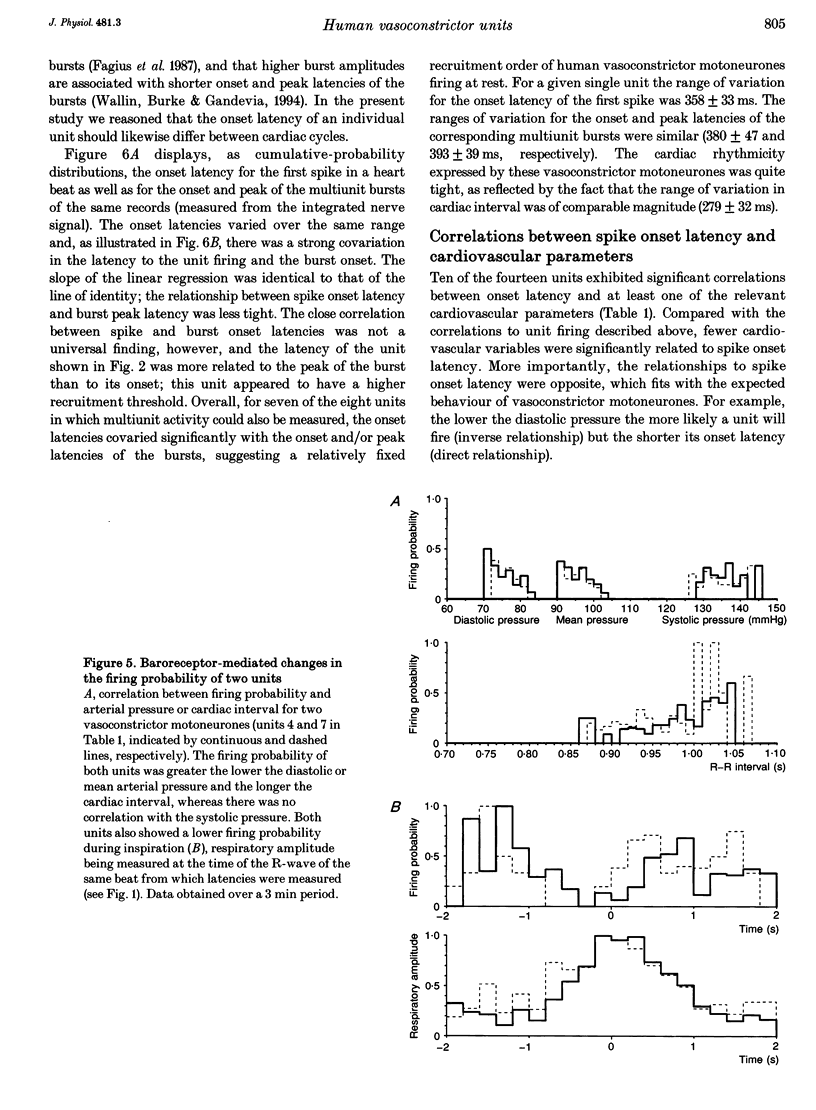
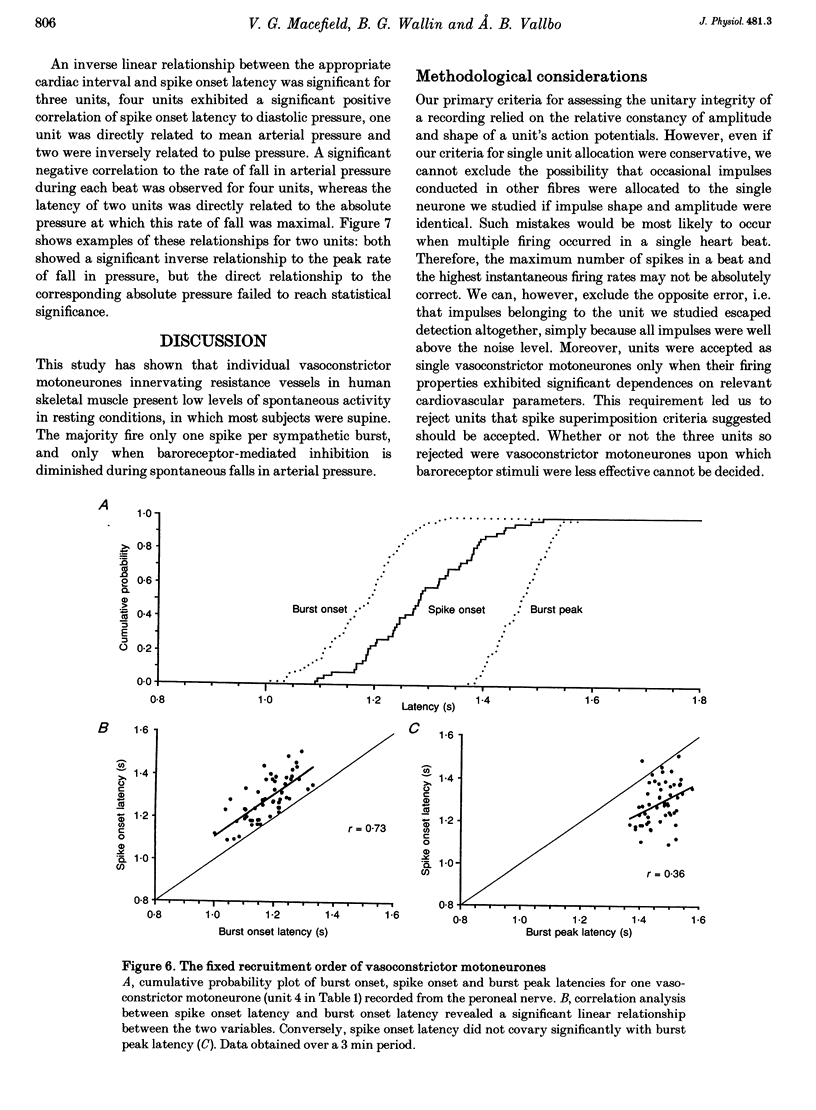
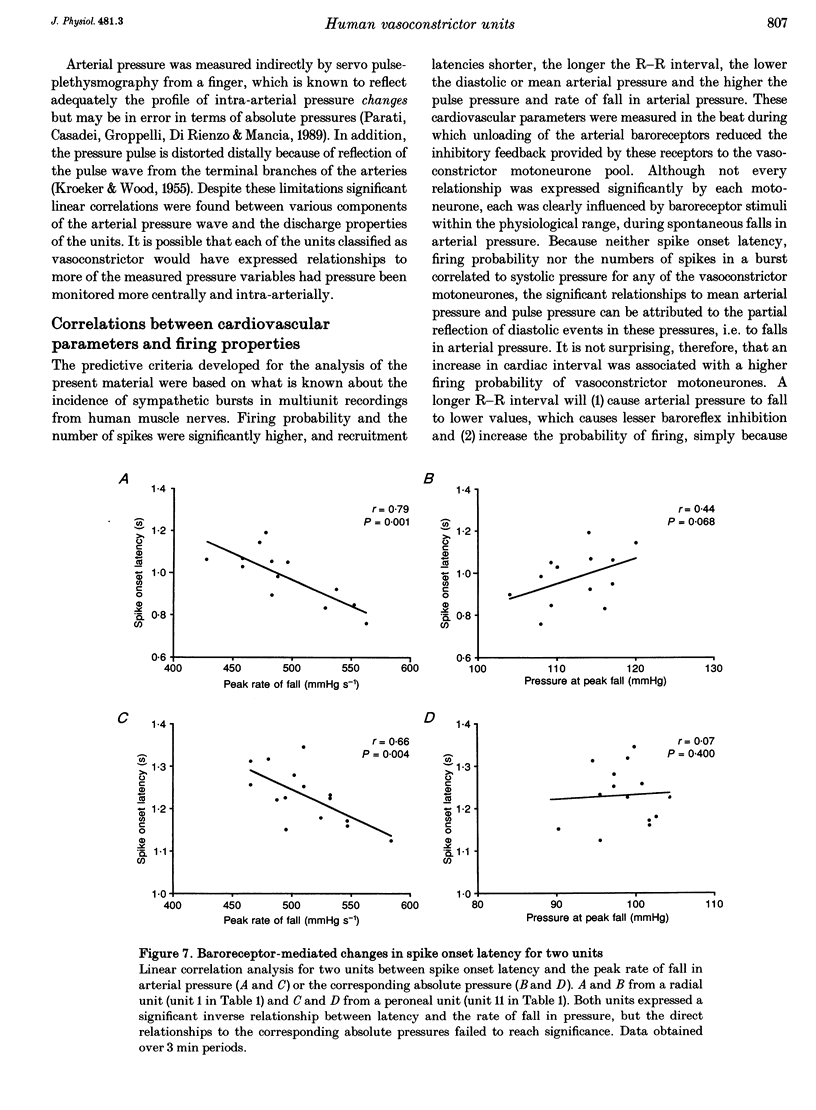
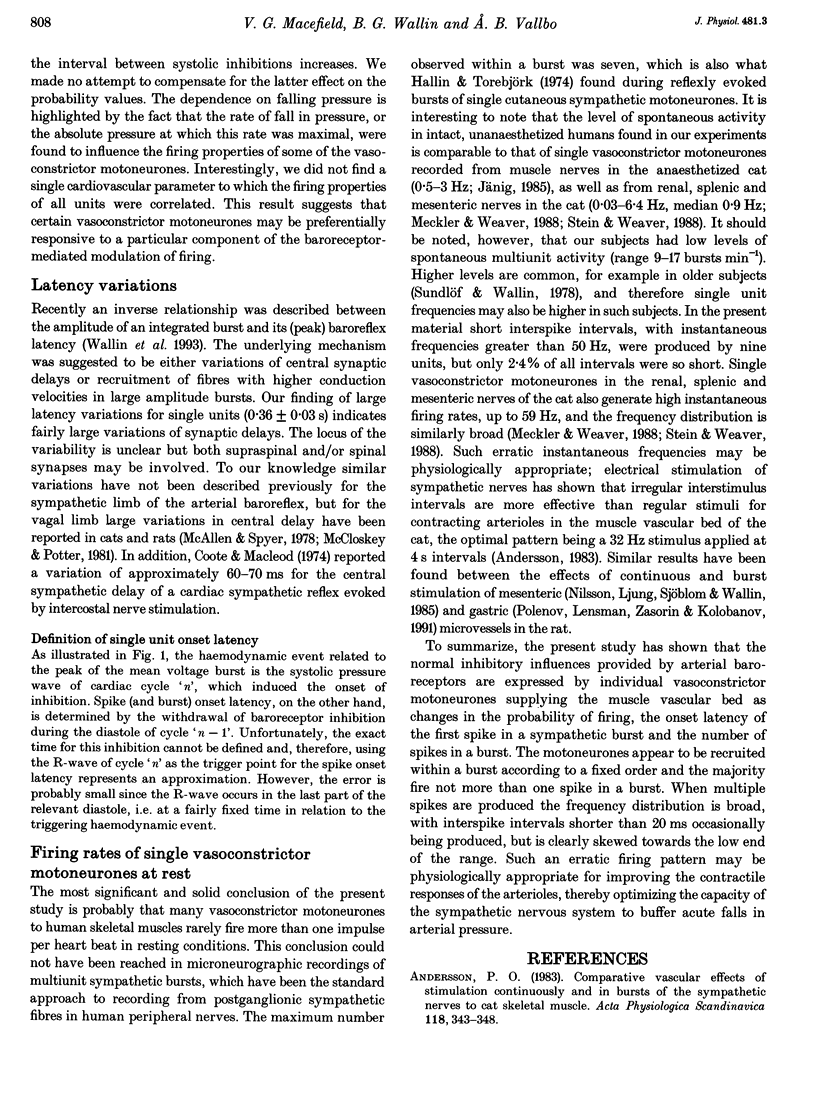
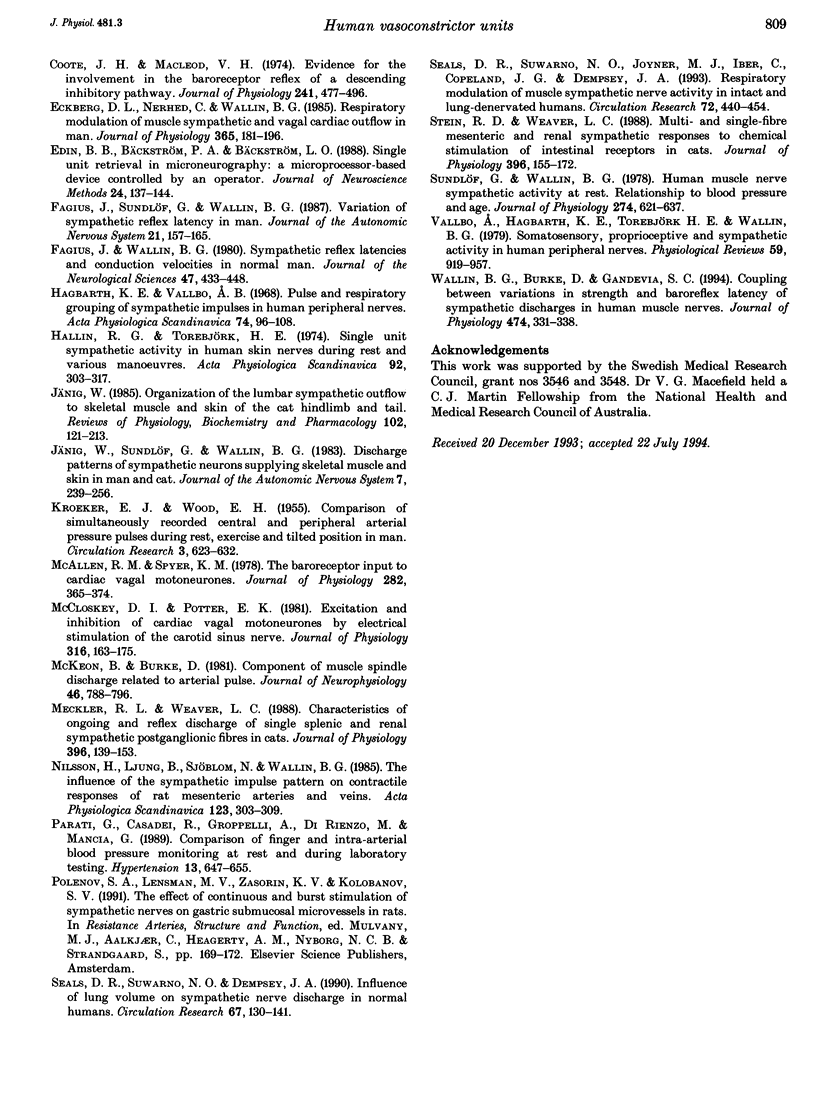
Selected References
These references are in PubMed. This may not be the complete list of references from this article.
- Andersson P. O. Comparative vascular effects of stimulation continuously and in bursts of the sympathetic nerves to cat skeletal muscle. Acta Physiol Scand. 1983 Aug;118(4):343–348. doi: 10.1111/j.1748-1716.1983.tb07281.x. [DOI] [PubMed] [Google Scholar]
- Coote J. H., Macleod V. H. Evidence for the involvement in the baroreceptor reflex of a descending inhibitory pathway. J Physiol. 1974 Sep;241(2):477–496. doi: 10.1113/jphysiol.1974.sp010667. [DOI] [PMC free article] [PubMed] [Google Scholar]
- Eckberg D. L., Nerhed C., Wallin B. G. Respiratory modulation of muscle sympathetic and vagal cardiac outflow in man. J Physiol. 1985 Aug;365:181–196. doi: 10.1113/jphysiol.1985.sp015766. [DOI] [PMC free article] [PubMed] [Google Scholar]
- Edin B. B., Bäckström P. A., Bäckström L. O. Single unit retrieval in microneurography: a microprocessor-based device controlled by an operator. J Neurosci Methods. 1988 Jun;24(2):137–144. doi: 10.1016/0165-0270(88)90057-x. [DOI] [PubMed] [Google Scholar]
- Fagius J., Sundlöf G., Wallin B. G. Variation of sympathetic reflex latency in man. J Auton Nerv Syst. 1987 Dec;21(2-3):157–165. doi: 10.1016/0165-1838(87)90018-x. [DOI] [PubMed] [Google Scholar]
- Fagius J., Wallin B. G. Sympathetic reflex latencies and conduction velocities in normal man. J Neurol Sci. 1980 Sep;47(3):433–448. doi: 10.1016/0022-510x(80)90098-2. [DOI] [PubMed] [Google Scholar]
- Hagbarth K. E., Vallbo A. B. Pulse and respiratory grouping of sympathetic impulses in human muscle-nerves. Acta Physiol Scand. 1968 Sep-Oct;74(1):96–108. doi: 10.1111/j.1748-1716.1968.tb04218.x. [DOI] [PubMed] [Google Scholar]
- Hallin R. G., Torebjörk H. E. Single unit sympathetic activity in human skin nerves during rest and various manoeuvres. Acta Physiol Scand. 1974 Nov;92(3):303–317. doi: 10.1111/j.1748-1716.1974.tb05749.x. [DOI] [PubMed] [Google Scholar]
- Jänig W. Organization of the lumbar sympathetic outflow to skeletal muscle and skin of the cat hindlimb and tail. Rev Physiol Biochem Pharmacol. 1985;102:119–213. doi: 10.1007/BFb0034086. [DOI] [PubMed] [Google Scholar]
- Jänig W., Sundlöf G., Wallin B. G. Discharge patterns of sympathetic neurons supplying skeletal muscle and skin in man and cat. J Auton Nerv Syst. 1983 Mar-Apr;7(3-4):239–256. doi: 10.1016/0165-1838(83)90077-2. [DOI] [PubMed] [Google Scholar]
- KROEKER E. J., WOOD E. H. Comparison of simultaneously recorded central and peripheral arterial pressure pulses during rest, exercise and tilted position in man. Circ Res. 1955 Nov;3(6):623–632. doi: 10.1161/01.res.3.6.623. [DOI] [PubMed] [Google Scholar]
- McAllen R. M., Spyer K. M. The baroreceptor input to cardiac vagal motoneurones. J Physiol. 1978 Sep;282:365–374. doi: 10.1113/jphysiol.1978.sp012469. [DOI] [PMC free article] [PubMed] [Google Scholar]
- McCloskey D. I., Potter E. K. Excitation and inhibition of cardiac vagal motoneurones by electrical stimulation of the carotid sinus nerve. J Physiol. 1981 Jul;316:163–175. doi: 10.1113/jphysiol.1981.sp013780. [DOI] [PMC free article] [PubMed] [Google Scholar]
- McKeon B., Burke D. Component of muscle spindle discharge related to arterial pulse. J Neurophysiol. 1981 Oct;46(4):788–796. doi: 10.1152/jn.1981.46.4.788. [DOI] [PubMed] [Google Scholar]
- Meckler R. L., Weaver L. C. Characteristics of ongoing and reflex discharge of single splenic and renal sympathetic postganglionic fibres in cats. J Physiol. 1988 Feb;396:139–153. doi: 10.1113/jphysiol.1988.sp016955. [DOI] [PMC free article] [PubMed] [Google Scholar]
- Nilsson H., Ljung B., Sjöblom N., Wallin B. G. The influence of the sympathetic impulse pattern on contractile responses of rat mesenteric arteries and veins. Acta Physiol Scand. 1985 Mar;123(3):303–309. doi: 10.1111/j.1748-1716.1985.tb07592.x. [DOI] [PubMed] [Google Scholar]
- Parati G., Casadei R., Groppelli A., Di Rienzo M., Mancia G. Comparison of finger and intra-arterial blood pressure monitoring at rest and during laboratory testing. Hypertension. 1989 Jun;13(6 Pt 1):647–655. doi: 10.1161/01.hyp.13.6.647. [DOI] [PubMed] [Google Scholar]
- Seals D. R., Suwarno N. O., Dempsey J. A. Influence of lung volume on sympathetic nerve discharge in normal humans. Circ Res. 1990 Jul;67(1):130–141. doi: 10.1161/01.res.67.1.130. [DOI] [PubMed] [Google Scholar]
- Seals D. R., Suwarno N. O., Joyner M. J., Iber C., Copeland J. G., Dempsey J. A. Respiratory modulation of muscle sympathetic nerve activity in intact and lung denervated humans. Circ Res. 1993 Feb;72(2):440–454. doi: 10.1161/01.res.72.2.440. [DOI] [PubMed] [Google Scholar]
- Stein R. D., Weaver L. C. Multi- and single-fibre mesenteric and renal sympathetic responses to chemical stimulation of intestinal receptors in cats. J Physiol. 1988 Feb;396:155–172. doi: 10.1113/jphysiol.1988.sp016956. [DOI] [PMC free article] [PubMed] [Google Scholar]
- Sundlöf G., Wallin B. G. Human muscle nerve sympathetic activity at rest. Relationship to blood pressure and age. J Physiol. 1978 Jan;274:621–637. doi: 10.1113/jphysiol.1978.sp012170. [DOI] [PMC free article] [PubMed] [Google Scholar]
- Vallbo A. B., Hagbarth K. E., Torebjörk H. E., Wallin B. G. Somatosensory, proprioceptive, and sympathetic activity in human peripheral nerves. Physiol Rev. 1979 Oct;59(4):919–957. doi: 10.1152/physrev.1979.59.4.919. [DOI] [PubMed] [Google Scholar]
- Wallin B. G., Burke D., Gandevia S. Coupling between variations in strength and baroreflex latency of sympathetic discharges in human muscle nerves. J Physiol. 1994 Jan 15;474(2):331–338. doi: 10.1113/jphysiol.1994.sp020025. [DOI] [PMC free article] [PubMed] [Google Scholar]


